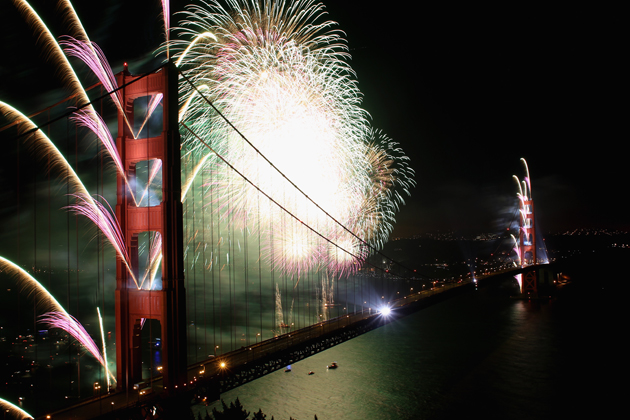The Golden Gate Bridge 75th Anniversary
On 27 May 2012 San Franciscans showed the world just how much the Golden Gate bridge means to them with an amazing fireworks display to celebrate 75 years of service. At the time it was built it was the longest bridge in the world and many said it could not be done. Having visited it and walked over and back (there is no bus stop the other side!), it really is a remarkable structure and location.

Ezra Shaw, Getty Images
To put it in context, when the bridge was designed and built:
- There were no calculators – as we know them now, “calculators” in the 1930s were office clerks who would spend months solving a single linear system of equations, as is required for an indeterminate structure such as this. This can be accomplished in seconds now even on the cheapest laptop. The command in Matlab is “x = Ab”. We have it easy.
- There were no total stations – setting the bridge out was done with theodolites and good eyesight! Coordinates, angles, and distances were all calculated manually. There were no laser sights or satellites to check the GPS coordinates of the reference points.
- There was no Microsoft Project – planning and delivery of such a complex project was again carried out manually with (obviously) no help from a computer. Network path analysis was in its infancy, and yet the bridge was built in a nifty 51 months.
- There was no limit state design or partial factor format codes of practice – instead allowable stress design was used, with far less information available on the material performance under cyclic and dynamic loading than we have today. Aerodynamic forces were not understood nor worried about – the Tacoma Narrows Bridge collapse was a decade later.
- Finally, and just to get my research in, there was of course no traffic microsimulation assessment of the loading that the traffic would impart to the bridge. This would come nearly 75 years later!
The main span is 1280.2 m. The current longest span is 1991 m (Akashi Kaikyo Bridge, which I also had the pleasure of visiting), which is only 50% longer approximately, and was achieved without any of the above restrictions. In this context, the designers and builders of this bridge, and many others like it at the time, certainly deserve an awe and reverence for their achievements. But surely, don’t many other bridges deserve this attention? We trust our lives every day to their builders and the materials, and our economies could not function without them. It is no surprise that “to build bridges” is a very positive metaphor.
« Journal paper published – footbridge vibration
Comment from klark
Time: 4 August, 2012, 03:21
Wow! I imagine this, what if engineers today will going to design and construct the bridge in that situation?